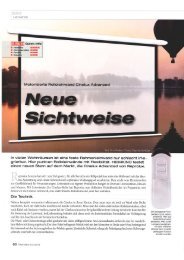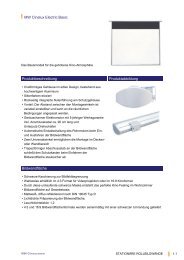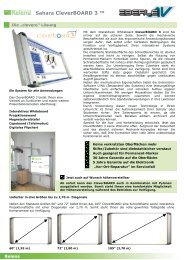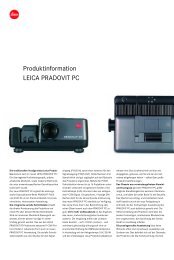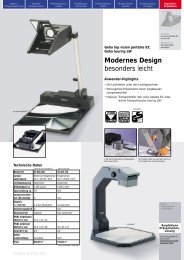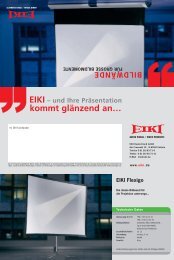Genelec 1029A Bi-amplified Monitoring System - Eberle AV
Genelec 1029A Bi-amplified Monitoring System - Eberle AV
Genelec 1029A Bi-amplified Monitoring System - Eberle AV
You also want an ePaper? Increase the reach of your titles
YUMPU automatically turns print PDFs into web optimized ePapers that Google loves.
Figure 3: Using two sources.<br />
Figure 4: Using one monitor and a<br />
stereo source.<br />
AMPLIFIERS<br />
AMPLIFIERS<br />
The bass and treble amplifiers<br />
produce 40 W of output power<br />
each, with very low THD and IM<br />
distortion values. The amplifiers<br />
are designed to ensure the highest<br />
subjective sound quality<br />
currently possible. The amplifier<br />
unit also contains a protection circuit<br />
that monitors the output levels<br />
and prevents any damage to the<br />
drivers. This makes the system<br />
immune to overloads and spurious<br />
signals.<br />
DRIVERS<br />
DRIVERS<br />
A 19 mm ( 3 /4") metal dome tweeter<br />
is loaded by a DCW, and is used<br />
to reproduce the high frequencies.<br />
The DCW is integrated into<br />
the one piece cabinet front baffle.<br />
Figure 5: The reference axis lies<br />
between bass and treble drivers.<br />
The 130 mm (5") woofer is a bass<br />
cone driver mounted in a 4.5 litre<br />
vented cabinet. The -3 dB frequency<br />
is 68 Hz and the low<br />
frequency response extends<br />
down to 65 Hz (-6dB).<br />
Protective grills are positioned in<br />
front of both drivers. Magnetic<br />
shielding is standard on the <strong>1029A</strong>.<br />
Shielding is vital for applications<br />
such as video post production,<br />
where stray magnetic fields must<br />
be minimized.<br />
DCW DCW TECHNOLOGY<br />
TECHNOLOGY<br />
The revolutionary Directivity Control<br />
Waveguide (DCW) technology<br />
is a means of greatly improving<br />
the performance of a direct radiating<br />
multi-way loudspeaker<br />
under normal listening conditions.<br />
One of the basic aims is to match<br />
the performance of the drivers in<br />
terms of both frequency response<br />
and directivity. This results in a<br />
smoother overall frequency response<br />
on and off axis. In addition,<br />
the improved directivity control<br />
causes more direct sound and<br />
less reflected sound to be received<br />
at the listening position.<br />
This provides improved stereo<br />
imaging and ensures that the system<br />
is less sensitive to differing<br />
control room acoustics than conventional<br />
direct radiator design.<br />
The DCW Technology improves<br />
the drive unit sensitivity by +2 to<br />
+6 dB (depending on the particular<br />
application), thus also<br />
increasing the available system<br />
maximum sound pressure level.<br />
MOUNTING<br />
MOUNTING<br />
There are several possibilities for<br />
mounting the <strong>1029A</strong>. On the base<br />
of the monitor is a 3 /8" UNC threaded<br />
hole which can accommodate a<br />
standard microphone stand.<br />
There is a provision for an Omnimount®<br />
size 50 bracket,for which<br />
two M6x10mm screws are required.<br />
Alternatively the speaker<br />
can be hung on M4 screws with<br />
suitable heads by one of the three<br />
keyhole slots on the backpanel.<br />
The speaker can be hung in a<br />
horizontal or vertical position. Friction<br />
pads are provided for<br />
placement on a shelf or a stand.<br />
OPTIONS<br />
OPTIONS<br />
The <strong>1029A</strong> is available in three<br />
colours: black, grey and white.<br />
The driver's protective grilles,<br />
volume and power knobs and<br />
stickers on the back of the loudspeaker<br />
are black regardless of<br />
cabinet colour. Other options include<br />
wall and ceiling mounts,<br />
table stand and soft carrying bag.<br />
Ask your local <strong>Genelec</strong> dealer for<br />
more details.<br />
AUDIO PRECISION <strong>1029A</strong> LEVEL(dBr) vs FREQ(Hz)<br />
17 AUG 96 10:32:56<br />
100<br />
95<br />
90<br />
85<br />
80<br />
75<br />
70<br />
65<br />
60<br />
55<br />
100<br />
95<br />
90<br />
20 100 1k 10k 20k<br />
Figure 6: The upper curve group shows the horizontal directivity<br />
characteristics of <strong>1029A</strong> measured at 1 m. The lower curve is the total<br />
radiated power response. Uin=-20 dBu.<br />
AUDIO PRECISION <strong>1029A</strong> LEVEL(dBr) vs FREQ(Hz)<br />
23 SEP 96 10:24:33<br />
100<br />
95<br />
90<br />
85<br />
80<br />
75<br />
70<br />
65<br />
60<br />
55<br />
50<br />
BASS TILT<br />
2+3+4 OFF<br />
3 ON<br />
4 ON<br />
3+4 ON<br />
2+3+4 ON<br />
BASS ROLL-OFF<br />
Figure 7: The curves show the effect of the 'bass tilt', 'treble tilt' and 'bass<br />
roll-off' controls on the free field response.<br />
Figure 8: The <strong>1029A</strong>s and 1091A subwoofer.<br />
0 15<br />
30<br />
45<br />
TREBLE TILT<br />
1 OFF<br />
20 100 1k 10k 20k<br />
1 ON



